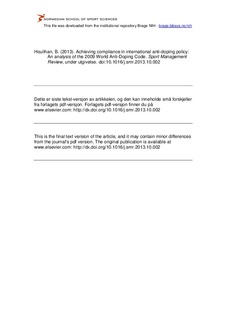| dc.contributor.author | Houlihan, Barrie | |
| dc.date.accessioned | 2014-03-14T14:20:27Z | |
| dc.date.available | 2014-03-14T14:20:27Z | |
| dc.date.issued | 2013-12-08 | |
| dc.identifier.citation | Sport Management Review. 2013, under utgivelse | nb_NO |
| dc.identifier.uri | http://hdl.handle.net/11250/191664 | |
| dc.description | I Brage finner du siste tekst-versjon av artikkelen, og den kan inneholde små forskjeller fra forlagets pdf-versjon. Forlagets pdf-versjon finner du på www.sciencedirect.com: http://dx.doi.org/10.1016/j.smr.2013.10.002 / In Brage you'll find the final text version of the article, and it may contain minor differences from the journal's pdf version. The original publication is available at www.sciencedirect.com: http://dx.doi.org/10.1016/j.smr.2013.10.002 | nb_NO |
| dc.description.abstract | Despite the rapid acceptance by sports organisations of the World Anti-Doping Code and ratification by governments of the UNESCO Convention Against Doping in Sport there remains a concern that formal implementation disguises shallow compliance or depth of commitment. The paper distinguishes between adherence, implementation and compliance and examines the ways in which compliance has been measured by the World Anti-Doping Agency (WADA) and UNESCO. The aims of the paper are to evaluate the effectiveness of the current procedures for measuring and enhancing compliance and to suggest ways in which measurement could be improved and compliance strengthened. The research is based on an analysis of survey tools used by WADA and UNESCO to assess implementation and compliance; an analysis of recent International Observer reports published by WADA; and a series of interviews with anti-doping staff in international and national anti-doping organisations. The research found that the current survey tools are better at assessing formal implementation than depth of compliance and that recent International Observer reports indicate a significant concern with inadequate compliance among some event organisers and some participating countries. The factors that affect compliance are reviewed and suggestions are made regarding the strengthening of the monitoring of compliance, the improvement in compliance with the formal requirements of the Code and the deepening of day to day compliance. It is concluded that the rapid acceptance of the Code and Convention has masked the more difficult issue of developing the depth of commitment that is necessary to tackle the more complex issue of trafficking and the increasingly sophisticated doping strategies of some athletes. It is argued that changes are needed to the current monitoring and compliance systems if the current momentum in anti-doping policy is to be maintained. | nb_NO |
| dc.language.iso | eng | nb_NO |
| dc.publisher | Elsevier | nb_NO |
| dc.subject | VDP::Samfunnsvitenskap: 200::Økonomi: 210 | nb_NO |
| dc.subject | VDP::Samfunnsvitenskap: 200::Samfunnsvitenskapelige idrettsfag: 330 | nb_NO |
| dc.subject | doping | nb_NO |
| dc.subject | 2009 World Anti-Doping Code | nb_NO |
| dc.subject | UNESCO | nb_NO |
| dc.subject | compliance | nb_NO |
| dc.subject | monitor | nb_NO |
| dc.title | Achieving compliance in international anti-doping policy: An analysis of the 2009 World Anti-Doping Code | nb_NO |
| dc.type | Journal article | nb_NO |
| dc.type | Peer reviewed | nb_NO |
| dc.source.journal | Sport Management Review | nb_NO |
| dc.identifier.doi | 10.1016/j.smr.2013.10.002 | |
| dc.description.localcode | Seksjon for kultur og samfunn / Department of Cultural and Social Studies | nb_NO |
